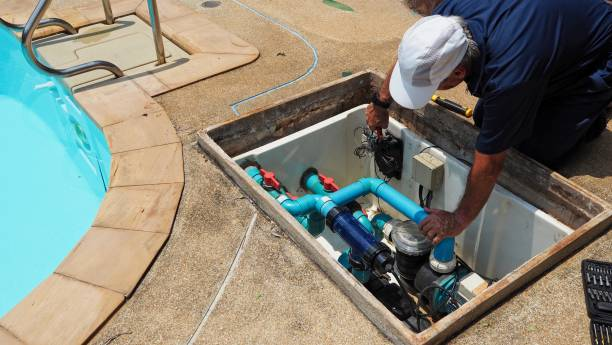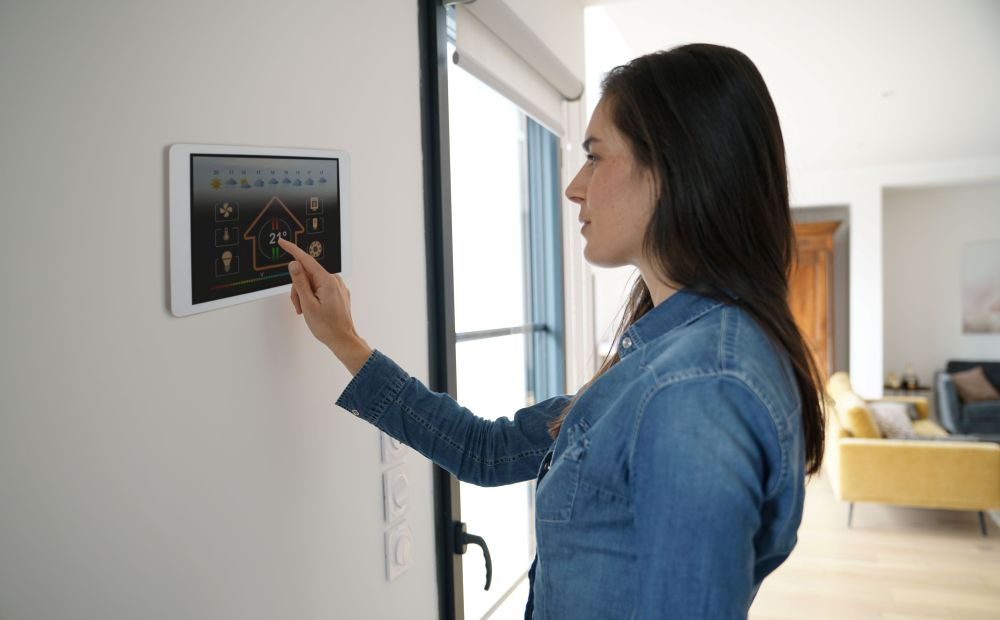The Importance of Proactive Home Maintenance
Maintaining your home is a continuous endeavor that goes far beyond aesthetics. It’s about preserving your investment, ensuring the safety and comfort of your family, and preventing minor issues from escalating into expensive, structural nightmares. Proactive home maintenance is the cornerstone of long-term property value and peace of mind.
Regular inspections and timely repairs can significantly extend the lifespan of your home’s components, from the roof over your head to the foundation beneath your feet. It allows us to catch small problems, like a hairline crack or a clogged gutter, before they lead to more extensive damage such as water intrusion, mold growth, or even structural compromise. By taking a preventative approach, we not only save money in the long run but also maintain a healthy and safe living environment.
This comprehensive approach to home care contributes directly to curb appeal and property value. A well-maintained home signals care and quality to potential buyers, should you ever decide to sell. More importantly, it ensures that your home remains a sanctuary, free from the stresses of unexpected and costly repairs.
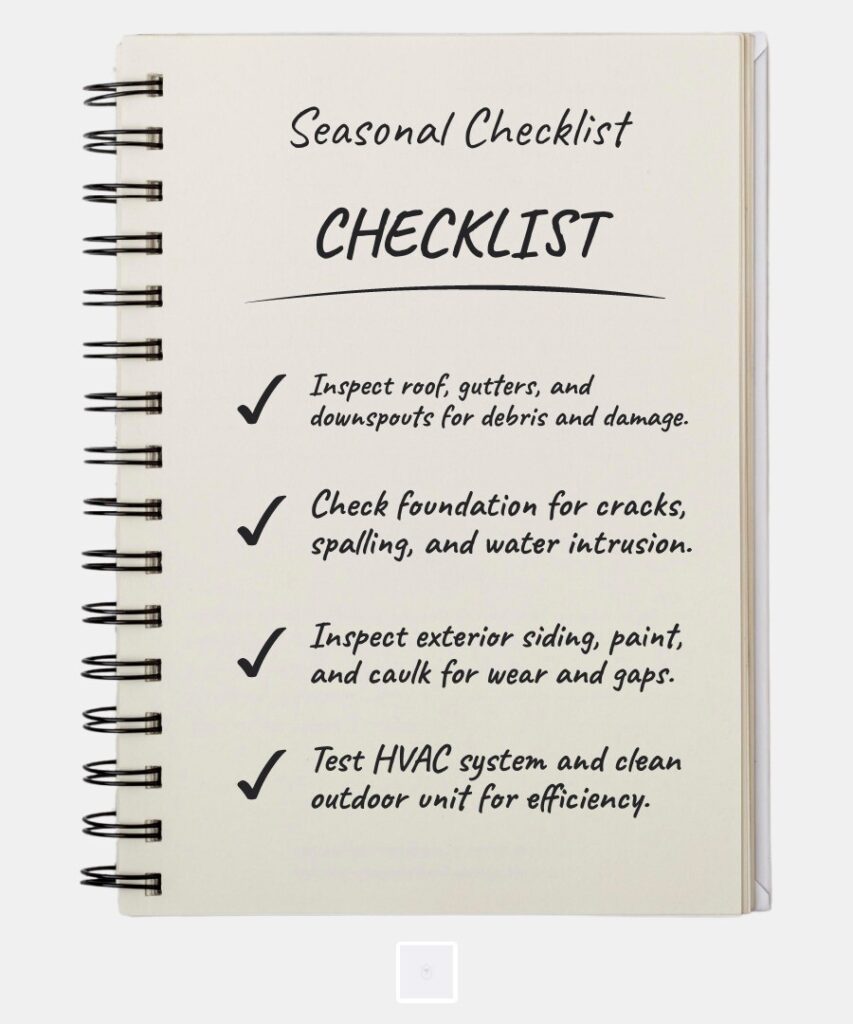
Foundational and Structural Integrity: The Core of Your Home
The foundation is, quite literally, the bedrock of your home. It supports the entire structure, distributing its weight evenly and protecting it from ground movement and environmental factors. When the foundation’s health is compromised, the integrity of your entire home is at risk. Issues such as water damage, soil pressure, and natural settling can lead to various problems, including the often-misunderstood phenomenon of foundation spalling.
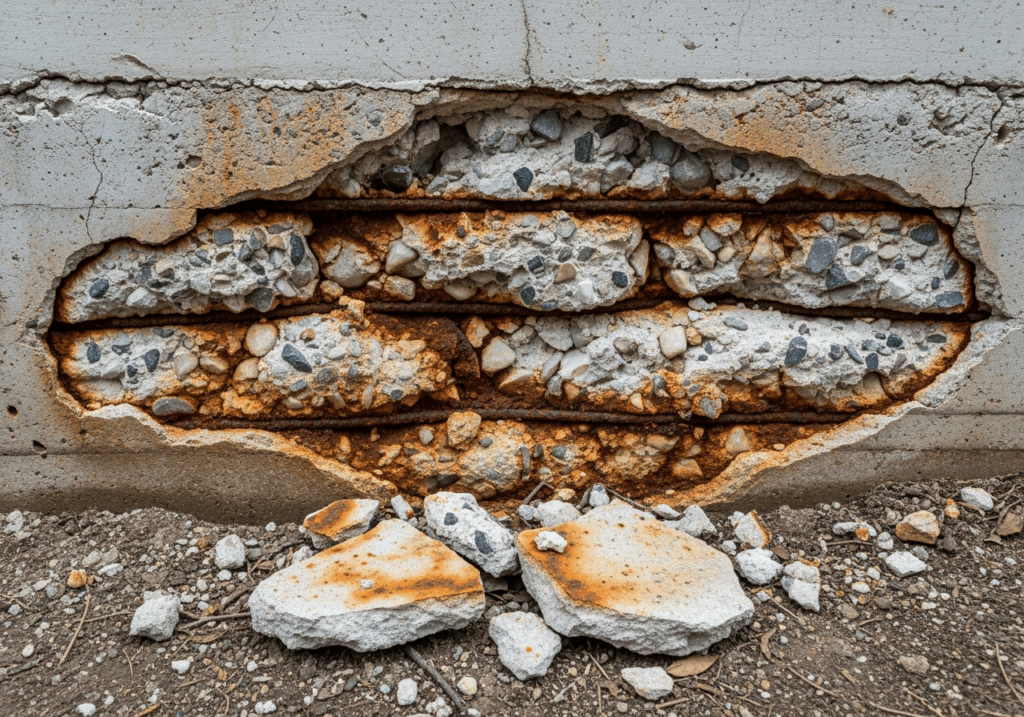
Identifying and Addressing Foundation Issues
Foundation problems can manifest in several ways, and recognizing these signs early is crucial. While some issues, like minor cracks, might seem insignificant, others, such as spalling concrete, can indicate serious underlying problems.
What is Foundation Spalling and Why is it a Problem? Foundation spalling refers to the breaking down of concrete into smaller sections, often appearing as flaking, chipping, or peeling on the surface. It can expose the aggregate beneath and, in severe cases, even the steel reinforcement (rebar) within the concrete. Spalling typically looks like pitted, “acne-scarred” concrete, with divots varying in diameter and depth.
The core problem with spalling is that it compromises the structural integrity of the foundation. Concrete is naturally porous, and when water seeps into these pores and reaches the reinforcing rebar, it causes the steel to rust. Rust expands significantly—up to 7 times its original thickness, exerting immense pressure (up to 9,000 pounds per square inch) on the surrounding concrete. This process, known as “oxide jacking” or “rust burst,” causes the concrete to crack and break off in chunks, leading to spalling. If left unaddressed, this continuous degradation weakens the foundation, making it vulnerable to further water intrusion and potential structural failure.
What are the Common Causes of Foundation Spalling? Several factors contribute to foundation spalling:
- Moisture and Freeze-Thaw Cycles: This is the most common cause. Water penetrates the concrete, and when temperatures drop below freezing, the water expands, putting pressure on the concrete. Repeated cycles lead to cracking and spalling.
- Rebar Corrosion (Oxide Jacking): As detailed above, rusting rebar is a primary driver of spalling, especially in reinforced concrete.
- Improper Concrete Mix or Curing: If the concrete mix had too much water, was not properly consolidated, or cured too quickly, it can be weaker and more susceptible to spalling.
- Alkali-Silica/Aggregate Reaction (ASR): This is a chemical reaction between certain types of silica in the aggregate and alkali hydroxides in the cement paste, in the presence of moisture. It forms a gel that expands, causing internal pressure and cracking, leading to spalling.
- Chloride Ion Exposure: In coastal areas or where de-icing salts are used, chloride ions can penetrate concrete, accelerating rebar corrosion and spalling.
- Air Pollution: Sulfates from air pollution can react with concrete components, especially in the presence of moisture, contributing to deterioration.
What are the Signs that Indicate Foundation Spalling? Beyond the visible flaking and chipping, look for:
- Pitted Surfaces: The concrete surface appears pockmarked or uneven.
- Exposed Aggregate: The small stones or gravel within the concrete become visible.
- Visible Rebar: In advanced stages, the steel reinforcement bars may be exposed and rusted.
- Powdery Residue: A fine, powdery substance might be present on or around the affected areas.
- Water Stains or Efflorescence: These indicate moisture penetration, which often precedes or accompanies spalling.
Other general foundation issues that often accompany or are confused with spalling include:
- Foundation Cracks: Hairline, vertical, horizontal, diagonal, or stair-step cracks. Horizontal cracks are particularly concerning as they often indicate significant soil pressure.
- Bowing Walls: Basement or crawl space walls that visibly curve inward.
- Uneven Floors: Floors that slope or sag, indicating differential settlement.
- Sticking Doors and Windows: Frames becoming misaligned due to foundation movement.
- Gaps: Gaps between walls and ceilings or floors, or separating baseboards.
- Water Intrusion: Leaks in the basement or crawl space, often accompanied by mold or musty odors.
For any concerns related to your home’s exterior, including the need for Amsterdam exterior masonry repair, it’s wise to consult with experienced professionals. They can provide a thorough assessment and recommend the most effective solutions.
The Cost-Benefit of Timely Repairs
Addressing foundation spalling and other structural issues promptly offers significant long-term benefits and cost savings.
What are the Long-Term Benefits of Addressing Foundation Spalling Promptly?
- Prevents Structural Damage: Timely repairs stop the progression of concrete deterioration, protecting the overall stability of your home.
- Avoids Higher Costs: Minor spalling repairs are far less expensive than addressing widespread structural damage or a full foundation replacement. Homeowners who address foundation problems promptly save an average of 20% on repair costs compared to those who delay.
- Maintains Home Value: Foundation issues can reduce a home’s value by 10% to 20%. Repairing them preserves and even improves your property’s marketability and resale value.
- Ensures Safety: A stable foundation is critical for the safety of your home and its occupants.
- Peace of Mind: Knowing your home’s foundation is sound provides invaluable peace of mind.
How Does the Cost of Foundation Spalling Repair Compare to the Cost of Potential Structural Damage if Left Untreated? The cost disparity is substantial.
- Foundation Spalling Repair Cost: This can range from $1,500 to $30,000, depending on the severity and method.
- Minor patching for small spalled areas might be a few hundred dollars.
- Concrete resurfacing for 100 square feet can cost $250 to $400.
- Repairing stem wall spalling with carbon fiber wraps averages around $5,000.
- More extensive repairs involving rebar treatment and concrete restoration will fall within this range.
- Cost of Untreated Structural Damage: If spalling is ignored and leads to broader structural issues:
- Traditional exterior foundation repairs (involving excavation) typically cost between $20,000 and $50,000.
- Major structural repairs, such as underpinning or extensive wall reinforcement, can range from $10,000 to $50,000+.
- A full foundation replacement can exceed $70,000 to $100,000.
- Beyond direct repair costs, you risk losing up to 20% of your home’s value.
Clearly, investing in timely spalling repair is a far more cost-effective strategy than waiting for the damage to escalate.
What is the Average Cost of Foundation Spalling Repair? As noted, the cost varies widely. For spalling, specific methods and their average costs include:
- Minor Patching/Resurfacing: For surface-level spalling without rebar exposure or structural concerns, costs might be in the $250 to $1,000 range for small areas.
- Carbon Fiber Wrap Repair: For stem wall spalling, this averages around $5,000.
- Comprehensive Repair (including rebar treatment, concrete restoration): This can range from $1,500 to $10,000+ per affected section, depending on the extent and depth of the damage.
How Do Factors Like the Severity of Damage, Location, and Materials Affect the Cost of Foundation Spalling Repair?
- Severity of Damage: Small, superficial spalling is cheaper to fix than deep spalling that exposes rusted rebar and compromises structural integrity. The more extensive the deterioration, the higher the cost.
- Location: Geographic location significantly impacts labor rates and material costs. Repairs in major metropolitan areas like Toronto or Chicago often cost more than in rural areas. Accessibility to the damaged area also plays a role; difficult-to-reach sections increase labor time and expense.
- Materials and Repair Method:Patching Compounds: Less expensive for minor issues.
- Epoxy/Polyurethane Injections: Good for sealing cracks associated with spalling, costing $250-$800 per crack.
- Cementitious Mortars/Resurfacers: Used for surface restoration.
- Carbon Fiber Wraps: Effective for structural reinforcement in spalled areas, averaging $5,000.
- Rebar Treatment: If rebar is rusted, it needs to be cleaned and treated with corrosion inhibitors, adding to the cost.
- Full Concrete Removal and Replacement: The most expensive option, reserved for severely compromised sections.
Are There Cost-Effective Alternatives or DIY Approaches for Minor Spalling Issues? For very minor, superficial spalling (e.g., small flecks without exposed rebar or structural cracks), a homeowner might consider DIY patching with a color-matching compound or concrete resurfacer. These are generally cosmetic fixes. However, if the spalling is indicative of deeper moisture problems, rebar corrosion, or structural weakness, DIY is not recommended. Foundation repairs are complex and require specialized knowledge and equipment. Attempting DIY repairs without proper expertise can lead to further damage and costlier repairs in the long run. Always consult a professional for anything beyond purely cosmetic surface issues.
What Should Homeowners Look for When Hiring a Contractor for Foundation Spalling Repair?
- Experience and Reputation: Choose a contractor with a proven track record in foundation repair, specifically with spalling issues. Check reviews, testimonials, and ask for references.
- Licensing and Insurance: Ensure the contractor is properly licensed and insured to protect yourself from liability.
- Warranties: A reputable contractor will offer a warranty on their work and materials.
- Detailed Estimates: Obtain multiple, itemized quotes from different contractors. The estimate should clearly outline the scope of work, materials, labor, and any potential additional costs.
- Independent Structural Engineer’s Assessment: For significant spalling or any structural concerns, hire an independent structural engineer. Their unbiased assessment (costing a few hundred dollars) will diagnose the problem accurately and recommend the necessary repairs, preventing contractors from overselling unnecessary services.
- Communication: Choose a contractor who communicates clearly, explains the repair process, and answers all your questions.
- Permits: Ensure the contractor will obtain all necessary permits for the work, as foundation repairs often require them.
The Cost-Benefit of Timely Repairs
- Early Detection Savings: Homeowners who address foundation problems promptly save an average of 20% on repair costs.
- Structural Failure Costs: Neglecting foundation issues can lead to costs ranging from $20,000 to $50,000 for exterior repairs, and over $70,000 for a full foundation replacement.
- Home Value Loss: Unrepaired foundation damage can decrease your home’s value by 10-20%.
- Professional Assessment: An independent structural engineer’s assessment (a few hundred dollars) can prevent unnecessary repairs and ensure the right solution.
- DIY Risks: DIY is only suitable for minor, cosmetic issues; complex repairs require professional expertise to avoid worsening the problem.
Securing Your Home’s Entry Points: Garage and Door Maintenance
Beyond the foundation, the integrity of your home’s entry points, particularly the garage and exterior doors, plays a crucial role in its safety, energy efficiency, and overall functionality. Neglecting these areas can lead to security vulnerabilities, increased energy bills, and costly repairs.
Garage Door Safety and Upkeep
Your garage door is often the largest moving part of your home and a primary entry point. Its complex system of springs, cables, rollers, and tracks requires regular attention to ensure smooth operation and safety.
- Roller Inspection: Regularly check the rollers for wear and tear, chips, or cracks. Worn rollers can cause the door to stick or operate noisily.
- Track Alignment: Ensure the tracks are clean and properly aligned. Any bends or obstructions can impede the door’s movement.
- Lubrication: Apply a silicone-based lubricant to moving parts like rollers, hinges, and springs to reduce friction and prevent rust.
- Auto-Reverse Test: Test the auto-reverse safety features monthly. Place an object (like a 2×4) in the door’s path. The door should reverse upon contact. For photoelectric sensors, wave your foot in front of the beam; the door should not close.
- Spring Tension: Garage door springs are under immense tension and are critical for lifting the door’s weight. Adjusting spring tension is highly dangerous and should only be performed by a professional. This is an area where the complexity often necessitates specialized knowledge, similar to the expertise required for AA commercial door repair. Mismanaging spring tension can lead to serious injury or further damage to the garage door system.
Regular professional maintenance can identify potential issues before they become critical, ensuring your garage door operates safely and efficiently for years to come.
Maintaining Exterior Doors and Windows
Exterior doors and windows are vital for your home’s security and energy envelope.
- Sealant and Caulk Inspection: Check the caulking and weather stripping around doors and windows for cracks, gaps, or deterioration. Replace any compromised seals to prevent drafts and water intrusion.
- Lock Functionality: Ensure all locks operate smoothly and securely. Lubricate mechanisms as needed.
- Hinge Maintenance: Tighten loose hinge screws and lubricate hinges to prevent squeaks and ensure proper door swing.
- Window Frame Cleaning: Keep window frames clean to prevent dirt buildup that can affect their operation and appearance.
- Draft Prevention: Beyond seals, check for drafts around the edges of doors and windows. Installing door sweeps or insulating window frames can significantly improve energy efficiency.
A Homeowner’s Guide to Home Exterior Maintenance
The exterior of your home—roofing, siding, and gutters—acts as its first line of defense against the elements. Regular maintenance of these components is essential for protecting the structure underneath and maintaining your home’s aesthetic appeal.
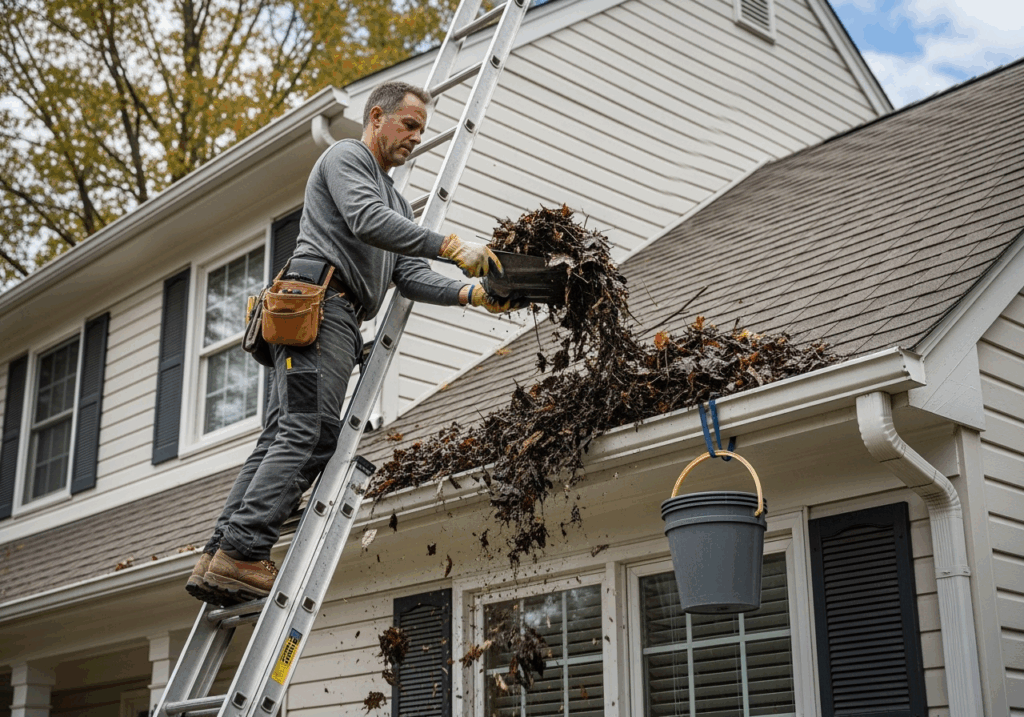
Roof and Gutter Home Exterior Maintenance
Your roof shields your home from rain, snow, and sun, while gutters direct water away from the foundation.
- Shingle Inspection: Annually, or after severe weather, inspect shingles for missing, cracked, curled, or blistering pieces. Pay attention to granular loss, which indicates wear.
- Flashing Integrity: Check the metal flashing around chimneys, vents, skylights, and valleys. Damaged flashing is a common source of leaks.
- Moss and Algae Growth: While some moss or algae might seem harmless, excessive growth can trap moisture, degrade shingles, and indicate underlying dampness. Consider professional cleaning or treatments.
- Gutter Cleaning: Clean gutters at least twice a year (more if you have many trees) to prevent clogs. Clogged gutters can cause water to overflow, damaging siding, fascia, and leading to foundation issues.
- Downspout Function: Ensure downspouts are clear and direct water at least 5-10 feet away from the foundation.
- Ice Dam Prevention: In colder climates, ensure your attic is properly insulated and ventilated to prevent ice dams, which can cause significant roof and water damage.
Siding and Paint Home Exterior Maintenance
Siding and paint protect your home’s walls and contribute significantly to its curb appeal.
- Vinyl Siding Cleaning: Clean vinyl siding annually with a soft brush and a mixture of water and mild detergent to remove dirt, mold, and mildew.
- Wood Siding Treatment: For wood siding, check for rot, insect damage, and peeling paint. Repaint or re-stain as needed to protect the wood from moisture.
- Paint Chipping and Peeling: Address chipped or peeling paint promptly. Not only does it look unsightly, but it also exposes the underlying material to weather damage.
- Pressure Washing Techniques: While effective for cleaning, use pressure washers with caution. Too much pressure can damage siding, especially wood or older materials. Always use the appropriate nozzle and maintain a safe distance.
- Caulking Gaps: Inspect and re-caulk any gaps or cracks in siding, trim, and around windows and doors to prevent water penetration.
Optimizing Your Home’s Climate Control Systems
Your HVAC (Heating, Ventilation, and Air Conditioning) system is crucial for maintaining a comfortable and healthy indoor environment. Regular maintenance of both indoor and outdoor units ensures optimal efficiency, extends system longevity, and can significantly impact your energy bills.

Maintaining Your Outdoor HVAC Unit
The outdoor unit (condenser) of your air conditioning system works hard, often exposed to the elements.
- Coil Cleaning: Annually, gently clean the condenser coils to remove dirt, dust, and debris. Clogged coils reduce efficiency and increase energy consumption. Turn off power to the unit before cleaning.
- Debris Removal: Keep the area around the outdoor unit clear of leaves, grass clippings, and other debris. Obstructions can block airflow and force the unit to work harder.
- Leveling the Unit: Check if the unit is level. Over time, the ground beneath it can settle. An unlevel unit can strain components and reduce efficiency. Use shims if necessary, but consult a professional if significant leveling is required.
- Checking Refrigerant Lines: Inspect the refrigerant lines (the copper tubes connecting the outdoor and indoor units) for any signs of damage or leaks. If you notice ice buildup on the lines, it’s a sign of a problem requiring professional attention.
- Improving Your Home HVAC Air Quality: Regular maintenance of your outdoor unit, combined with timely filter changes and duct cleaning indoors, directly contributes to better home HVAC air quality. A well-maintained system filters out pollutants more effectively, ensuring the air you breathe is cleaner and healthier.
Landscaping and System Performance
The landscaping around your outdoor HVAC unit can either help or hinder its performance.
- Clearance for Airflow: Ensure there’s at least two feet of clear space around all sides of the unit to allow for proper airflow. This prevents the unit from overheating and operating inefficiently.
- Planting Considerations: While plants can help shade the unit and improve efficiency, avoid planting dense shrubs or trees too close. Choose plants that won’t shed excessive leaves or debris into the unit.
- Protecting Units from Damage: Consider installing a small fence or barrier to protect the unit from accidental damage from lawnmowers, trimmers, or pets.
- Shading Benefits: Strategic planting of deciduous trees or shrubs that provide shade during the hottest parts of the day can help reduce the unit’s workload, but ensure they don’t block airflow.
Frequently Asked Questions about Exterior Maintenance
How often should I inspect my home’s exterior?
We recommend a thorough inspection of your home’s exterior at least twice a year, typically in the spring and fall. After severe weather events (heavy storms, strong winds, hail), an additional inspection is prudent. Regular visual checks throughout the year can also help catch minor issues early.
Is it safe to perform minor foundation crack repairs myself?
For very small, non-structural hairline cracks (less than 1/8 inch wide) that are purely cosmetic and show no signs of water intrusion or movement, you might be able to seal them yourself with appropriate caulk or epoxy. However, if cracks are wider, growing, horizontal, or accompanied by other signs of foundation distress (like uneven floors, sticking doors, or water leaks), it is crucial to consult a qualified foundation repair professional or a structural engineer. Attempting DIY repairs on structural issues can lead to more significant and costly damage.
What are the biggest signs of a failing roof?
Key indicators of a failing roof include:
- Missing, cracked, curled, or brittle shingles.
- Granules in your gutters or downspouts, indicating shingle wear.
- Dark streaks or moss/algae growth on the roof surface.
- Water stains on your interior ceilings or walls, especially after rain.
- Sagging areas on the roof deck.
- Daylight visible in your attic.
- High energy bills that can sometimes be linked to poor roof insulation or ventilation.
Conclusion
Proactive home maintenance is not just a chore; it’s a strategic investment in the longevity, safety, and value of your property. From understanding the nuances of foundation spalling repair costs to ensuring your garage door operates smoothly and your HVAC system runs efficiently, every maintenance task contributes to a healthier home.
By adopting a diligent approach to inspections and repairs, we can prevent small problems from escalating into major financial burdens. This commitment to care provides invaluable peace of mind, knowing that your home is secure, efficient, and well-preserved. Building strong partnerships with trusted professionals for specialized tasks ensures that your home receives the expert attention it deserves. Let’s work together to protect and improve our most cherished asset for years to come.
Want to know about Don’t Let the Rain Catch You Off Guard: Home Maintenance Tips for the Wet Season Check out our Exterior category.


